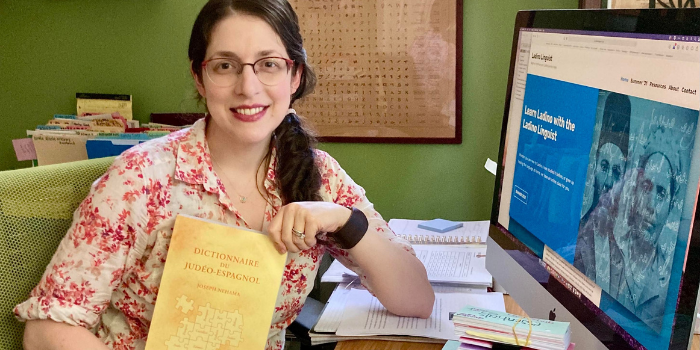Being Jewish
Feature
A Nearly Extinct Language Experiences a Zoom Boom
Four years ago, during a period of intense work on a family memoir, I had a mysterious dream:
I enter a bustling cafeteria where people are conversing loudly in a language I don’t understand. Judging by their apparel, it appears to be the 1920s or 1930s. I head upstairs to the quieter level and sit at a table for two. Soon an older woman with dark hair braided around her head sits down at my table. She looks like my maternal great-grandmother, Estrella. The woman starts to speak to me, and I realize that the language coming out of her mouth is Ladino. Though I don’t understand what she’s saying, I nod and listen. The noise of the other customers fades away. I don’t want to leave until I can understand her words.
Whenever I am learning a language on a deep level, it permeates my dreams. I have studied enough languages in my life that I now recognize this as a sign. It first happened in college when I studied abroad at the University of Haifa. After a few weeks of ulpan and speaking Hebrew with Israeli friends, I began to dream in Hebrew—whole conversations happening in a foreign language that I could somehow understand.
The same thing occurred when I studied Yiddish while earning my Ph.D. in modern Hebrew literature. In 2003, I took the enhabers (beginners) level at YIVO. Before long, I was singing Yiddish folksongs during the day and speaking mamaloshen in my dreams at night.
But I needed to master a different Jewish language to connect with my great-grandmother and truly understand the cultural bedrock of my Sephardi ancestry. And so, this past year, I began formal study of my third Jewish language, Ladino, also known as Judeo-Spanish and Djudezmo.

Based on medieval Castilian, Ladino is central to the heritage of Sephardi Jews. In the centuries after the Jews’ expulsion in 1492 and the Spanish Inquisition, Ladino traveled with Sephardim as they settled in the lands of the Ottoman Empire and points beyond (including in Bulgaria, the focus of the travel story on page 38). My mother’s maternal grandparents, born in Turkey and the island of Rhodes in the late 19th century, spoke Ladino as their native language while participating in the multilingual societies around them. When my great-grandmother emigrated from Rhodes to Zimbabwe in the 1920s, she learned English, too, but continued speaking Ladino within the Sephardi community in Zimbabwe’s capital city, Harare.
In some ways, my experience learning Ladino—first in an intensive course I took in January of this year and then in two classes over the summer—was similar to other language courses I’ve taken: There were verb charts and worksheets, group work and listening exercises. We explored everyday topics like the weather, professions and food shopping.
In one important way, though, my Ladino experience has been vastly different because I have studied entirely online, viewing my teacher and fellow students through a screen (ekran). I took part in the widely reported phenomenon dubbed the “Ladino Zoom Boom,” part of the profusion of online learning during pandemic-induced stay-at-home orders. Fueled by eager students with extra time on their hands (manos), this global virtual movement has involved hundreds of students of varying backgrounds, ages and religions. Our goal? To learn enough of muestro spanyol—“our Spanish,” one of Ladino’s traditional nicknames—to actually call it our own.
My platform of choice was the Ladino Linguist website run by Bryan Kirschen, a Binghamton University professor of romance languages and linguistics. Classmates logged on from a farm in England, apartments in Istanbul and Tel Aviv, homes in Japan, Germany and California. With Kirschen’s encouragement, we chatted about movies and conducted impromptu debates in Ladino. Additionally, each week we explored Sephardi folk culture through refranes (sayings), konsejikas (little stories) and kantikas (songs).
Soon, many classmates became friends—grateful not only for the chance to study such a historically important language, but also for the space to gather as a group during a time of profound social isolation. Virtual Ladino classes have been “a gamechanger,” said Ryuki, a Japanese Ph.D. student in comparative literature who has chosen to focus on Jewish writing and who had tried unsuccessfully to study Ladino on his own. Buoyed by the joy of learning with others this summer, he woke up at 3 a.m. to attend moabet (conversation) class. Ryuki, who asked that his full name not be used, is one of about half a dozen Japanese academics who are studying Ladino.
Kirschen, who began his efforts to revive Ladino as a University of California, Los Angeles, graduate student, calls this virtual community “Ladino 2.0.” He views the social connections as an exciting aspect of the online-learning era. “It’s creating opportunities that would have never existed before. We’re connecting people around the world who are creating their own friendships and relationships outside of class…. It’s going to continue to be important in the years to come.”
Indeed. In the bigger calculus of Ladino’s continued existence, speakers will need each other as much as the language needs us.
If typical linguistic scales are any indication, Ladino is at a critical inflection point. Estimates vary, but the Jewish Language Project surmises that there are around 100,000 Ladino speakers, with the largest concentrations in Israel, Turkey and the United States. Based on the dwindling number of native speakers, Ladino is classified as “highly endangered,” “moribund” or “nearly extinct.” Frequently in nonacademic circles and in the media, Ladino is labeled “a dying language.”
“Can we expand beyond that?” asked Ignacio Montoya, a linguist at the University of Nevada, Reno, who ended up in one of my Zoom courses over the summer. Raised Catholic in southern New Mexico, Montoya converted to Judaism over a decade ago after years of feeling drawn to Judaism’s history, culture and rituals. Today, he specializes in endangered languages and revitalization, and is currently working with tribal communities that speak Paiute, an indigenous language of the Great Basin region of the United States. Montoya suggests—and others in his field prefer—the terms “sleeping” or “dormant” over “extinct” to describe a language without native speakers. “The idea is that there can be an awakening,” he told me.

For an example of linguistic reawakening, we need only look to the success of modern Hebrew, an astonishing feat of language revival. Indeed, immersive ulpan was the model I had in mind when I enrolled in Ladino classes this summer. From my home office overlooking a sliver of Lake Washington in Seattle, I haltingly spoke, joked and listened in muestro spanyol multiple days per week. As I did so, I imagined myself back in the places where my Sephardi relatives would have spoken Ladino: chatting over a pot of fasulia (stewed green beans) in someone’s kitchen in Harare; whispered in the women’s balcony at the Kahal Shalom synagogue on Rhodes; shopping at the confectionary owned by Ottoman Jewish immigrants in Seattle’s Central District. As my comprehension skills improved week to week, it began to feel reasonable to think I might one day be able to read Ladino texts and incorporate more of this evocative language into my writing projects.
Learning words like karpuz (watermelon), bavajadas (nonsense) and fitijo (naughty child), I found ways to incorporate Ladino into my everyday life. Imagine my surprise, then, upon discovering that Ladino was entering my children’s lives, too. One spring day, when schools were operating remotely, I overheard my third grader participating in a discussion about heritage languages spoken at home. (His school includes speakers of Mongolian, Korean, Amharic, Arabic, Spanish and more.) My son chose to record a Ladino expression for his class: “Bivas, kreskas, enfloreskas!” This expression, like gesundheit or labriut, is typically said when someone sneezes. It translates as “Live, grow, thrive!” and can be followed by a second phrase, “komo un peshiko en aguas freskas, amen!,” which means “like a little fish in fresh water, amen!” I had started saying bivas around the house when I learned it in January, and by May it had become a piece of Sephardi heritage that my son could teach his class.
Another of my favorite Ladino phrases is “Kon bien amaneskas,” which, like bivas, is formed using the subjunctive mood. This goodnight expression can be translated as “may you dawn well” or “may you arise well.” How lovely to part with someone at nighttime by wishing them a pleasant morning.
As I think about my journey into Ladino, and the journeys of my fellow travelers, the verb amaneser, “to dawn” or “to rise,” is an apt symbol.
“There’s something that awakens in me when I hear Ladino,” said Robin, who preferred not to share her last name. The resident of Cape Town, South Africa, has studied with Kirschen the past two summers. Her Ladino classes have inspired her to investigate the legends passed down from her Sephardi relatives, Berbers from Morocco who lived for a time in Portugal.
Likewise, the language has deeply impacted Montoya, the linguist in Nevada. When he studied for his conversion, Judaism was taught through an essentially Ashkenazi lens. “When I discovered Ladino,” he said, “it drew me in.” Montoya appreciates the language as a portal into more diverse perspectives on Jewish culture.
Recognizing the shift wrought by the latest flowering of virtual students, some commentators are starting to use the words “revival” and “renaissance” to refer to Ladino. Is it too soon to tell if this language will survive and possibly even thrive at the dawn of a new, technologically aided era? Can the growing community of online learners sustain this centuries-old source of Sephardi pride? Asked about Ladino’s future, Kirschen is both pragmatic and optimistic.
“Ladino will be endangered, but it can still live on,” he told me. “There is so much potential.”
As intense and rewarding as my Ladino studies have been, I haven’t repeated the pleasure of dreaming in muestro spanyol. I will continue to work hard while holding onto one hope above all—that the next time I see my Sephardi great-grandmother in a dream, we will be able to speak her language, our Spanish, together.
Hannah S. Pressman is currently at work on Galante’s Daughter, a memoir connecting her Sephardi family history to explorations of American Jewish identity. She lives in Seattle with her husband and three children.








 Facebook
Facebook Instagram
Instagram Twitter
Twitter
Vintura Chalom says
beautiful thoughts, beautiful article.
Judith Cohen says
I grew up in Seattle with a Sephardic mother and an Ashkenazi father. Some of my cousins and I took Spanish classes in school in hopes of understanding our Sephardic parents. Sadly my understanding of Ladino is more through context and not true literacy. I am now inspired by you to try Ladino classes online. Wishing you muchos y Buenos con parnasa.
Sylvia Brainin says
This article brought me right back to Camp Swig in the mid-70’s. The songbook of that era included a Ladino song: Cuando el Rey Nimrod. It was the first time I heard that there was a Sephardic equivalent to Yiddish.
Sandra Platzman says
https://www.sephardicbrotherhood.com is a wonderful source of learning about the Sephardic community here and around the world, and learning Ladino and about more our culture. I’ve enjoyed many of the lectures and highly recommended making the connection.